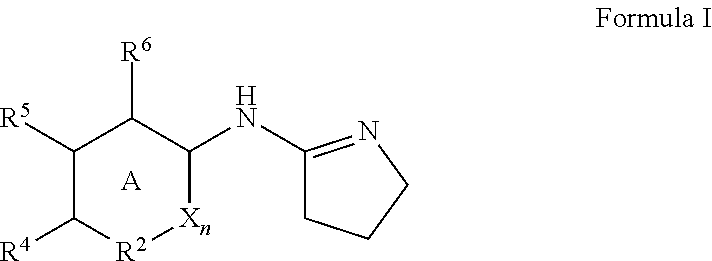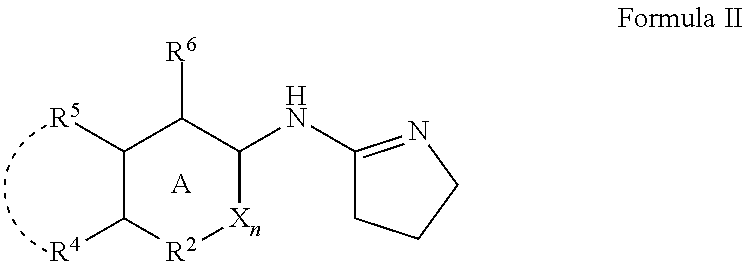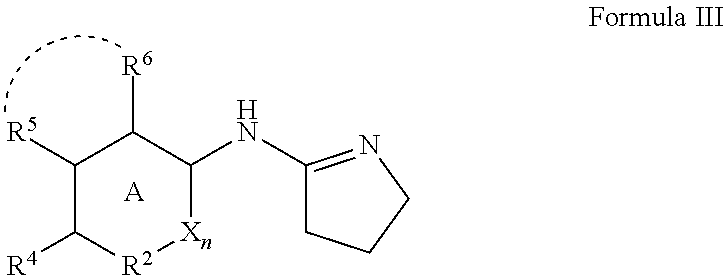Alpha adrenergic receptor modulators
a technology of adrenergic receptor and modulator, which is applied in the direction of biocide, cardiovascular disorder, drug composition, etc., can solve the problems of limited use of non-selective alpha-adrenergic blockers, low activity and specificity, and many compounds found to be effective agents in pain treatment are often found to have undesirable side effects
- Summary
- Abstract
- Description
- Claims
- Application Information
AI Technical Summary
Benefits of technology
Problems solved by technology
Method used
Image
Examples
example 1
N-1-Naphthyl-3,4-dihydro-2H-pyrrol-5-amine
Compound 1
[0242]A solution of POCl3 (765 mg) in 8 mL of toluene was added slowly to a solution of 2-pyrrolidinone (85 g) in 8 mL of toluene at 10° C. Then, the reaction was stirred at room temperature for 3 hours. A solution of 1-naphthylamine (858 mg) (CAS 134-32-7) in 8 mL of toluene was added, and the mixture was heated to reflux overnight. The refluxed mixture was cooled to room temperature, and the toluene layer was decanted. The residue was dissolved in aqueous water and DCM. Aqueous 5N NaOH was used to adjust the pH to alkaline. Two layers were separated, and the organic layer was washed with water and brine, dried over Na2SO4 and concentrated under reduced vacuum. Flash column chromatography (2-4% 7N NH3 in MeOH / DCM) yielded the title compound. 1H NMR (300 MHz, CD3OD) 2.09 (m, 2H), 2.61 (m, 2H), 3.86 (m, 2H), 7.27 (m, 1H), 7.45 (m, 1H), 7.57 (m, 2H), 7.87 (m, 2H), 7.99 (m, 1H).
[0243]Compounds 2, 3, 4, 5 and 6 were prepared in a simil...
example 2
N-(4-Chloro-1-naphthyl)-3,4-dihydro-2H-pyrrol-5-amine
Compound 7
[0245]A solution of POCl3 (382 mg) in 8 mL of toluene was added slowly to a solution of 2-pyrrolidinone (430 mg) in 8 mL of toluene at 10° C. Then, the reaction was stirred at room temperature for 3 hours. A solution of 4-chloro-1-naphthalenamine (CAS 4684-12-2) (533 mg) in 8 mL of toluene was added, and the mixture was heated to reflux overnight. The refluxed mixture was then cooled to room temperature, and the toluene layer was decanted. The residue was dissolved in aqueous water and DCM. Aqueous 5N NaOH was used to adjust the pH to alkaline. The resulting two layers were separated, and the organic layer was washed with water and brine, dried over Na2SO4 and concentrated under reduced vacuum. Flash column chromatography (24% 7N NH3 in MeOH / DCM) yielded the title compound. 1H NMR (300 MHz, CD3OD) δ 2.11 (m, 2H), 2.66 (m, 2H), 3.36 (t, J=6.74 Hz, 2H), 6.96 (d J=7.91 Hz, 1H), 7.49 (m, 2H), 7.50 (dd, J=1.13 & 7.11 Hz, 1H),...
example 3
8-Chloro-N-(3,4-dihydro-2H-pyrrol-5-yl)quinolin-7-amine
Compound 9
[0248]To a mixture of 2-chlorobenzene-1,3-diamine (24 mmol) (CAS 6400-14-2) and NaI (150 mg) in 80% H2SO4 (20 g) was added Glycerol (45 g). The mixture was stirred at 150° C. to 170° C. for 5 h. The mixture was cooled to room temperature. Aqueous 5N NaOH was used to adjust the pH to alkaline, which was then extracted with EtOAc washed with brine, dried over MgSO4 and concentrated under reduced vacuum. Flash column chromatography (EtOAc:Hexane) yielded 7-amino-8-chloroquinoline (800 mg), as a pale yellow solid. 1H NMR (300 MHz, CD3OD) δ: 8.69 (dd, J=4.4, 1.8 Hz, 1H), 8.13 (dd, J=7.9, 1.8 Hz, 1H), 7.61 (d, J=9.1 Hz, 1H), 7.14-7.29 (m, 2H)
[0249]A solution of POCl3 (551 mg) in 8 mL of toluene was added slowly to a solution of 2-pyrrolidinone (612 mg) in 8 mL of toluene at 10° C. Then the reaction was stirred at room temperature for 3 hours. A solution of 7-amino-8-chloroquinoline (760 mg) in 8 mL of toluene was added, and ...
PUM
| Property | Measurement | Unit |
|---|---|---|
| temperature | aaaaa | aaaaa |
| temperature | aaaaa | aaaaa |
| temperature | aaaaa | aaaaa |
Abstract
Description
Claims
Application Information
 Login to View More
Login to View More - R&D
- Intellectual Property
- Life Sciences
- Materials
- Tech Scout
- Unparalleled Data Quality
- Higher Quality Content
- 60% Fewer Hallucinations
Browse by: Latest US Patents, China's latest patents, Technical Efficacy Thesaurus, Application Domain, Technology Topic, Popular Technical Reports.
© 2025 PatSnap. All rights reserved.Legal|Privacy policy|Modern Slavery Act Transparency Statement|Sitemap|About US| Contact US: help@patsnap.com



